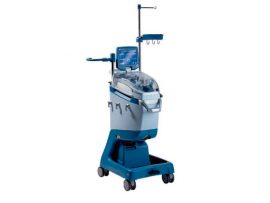Abstract Background We evaluated outcomes of neonatal cardiac surgery at hospitals affiliated with the European Congenital Heart Surgeons Association (ECHSA). Methods All patients ≤30 days of life undergoing a cardiac..
Read MoreAbstract Background Continuous blood gas monitoring (CBGM) during cardiopulmonary bypass (CPB) is essential for maintaining optimal patient outcomes, enabling rapid responses to critical fluctuations in blood gas parameters. This non-inferiority..
Read MoreAbstract Background Although goal-directed perfusion (GDP) during cardiopulmonary bypass (CPB) has been discussed extensively in adult studies, no pediatric indexed oxygen delivery (Do2i) thresholds are universally accepted, and no pediatric..
Read MoreAbstract Objective Hemolysis is a complication in surgical procedures requiring cardiopulmonary bypass (CPB). The primary aim of this study was to evaluate the effectiveness of the point-of-care device Hemcheck Helge..
Read MoreAbstract Introduction Biostatistics is an increasing focus in both the United States Medical Licensing exams (USMLE) and medical school curricula. Nonetheless, literature has documented that it is poorly understood among..
Read MoreAbstract Background: The sustained renal effects of exposure to cardiopulmonary bypass are unknown. This study aimed to test whether cardiopulmonary bypass (CPB) is associated with sustained renal tissue hypoxia and..
Read MoreAbstract Background: Ascorbic acid is a strong antioxidant that prevents postoperative delirium by inhibiting reactive oxygen species production. This pilot study was designed to investigate the prevalence of postoperative delirium among..
Read MoreAbstract Penetrating cardiac injury in children is a life-threatening emergency. The initial reaction of the witness and medical team management plays a crucial role in survival. We are reporting a..
Read MoreAbstract There is no consensus on the ideal sweep gas flow volume for achieving targeted blood partial gas pressures during cardiopulmonary bypass (CPB). The sweep gas flow rate is one..
Read MoreAbstract Background Congenital heart disease is the most common neonatal congenital condition. Surgery is often necessary. Patients with congenital heart disease are potentially exposed to red cell transfusion preoperatively, intraoperatively..
Read MoreAbstract Background On-pump coronary artery bypass grafting (CABG) triggers inflammatory responses as a result of surgical stress and extracorporeal circulation, which affect platelet and leukocyte activation while enhancing their intimate..
Read MoreAbstract Background There remains significant variability in the use of intraoperative mechanical circulatory support in lung transplantation. This report details our outcomes using elective cardiopulmonary bypass (CPB) in lung transplantation...
Read MoreAbstract Introduction Sternotomy has been the most common approach for the correction of congenital cardiac defects, and questions arise surrounding the safety, feasibility, and cost-effectiveness of implementing minimally invasive techniques..
Read MoreAbstract The branch-first technique (BFT) for aortic arch replacement eliminates deep hypothermia and global circulatory arrest, reducing cardiopulmonary bypass and ischemic times. We present our initial experience with BFT in..
Read MoreAbstract Brain injury and cerebral inflammation are frequent complications following cardiopulmonary bypass (CPB) resulting in neurocognitive dysfunction, encephalopathy, or stroke. We compared cerebral inflammation induced by del Nido and histidine-tryptophan-α-ketoglutarate..
Read MoreAbstract Background The impact of intra-aortic balloon pump (IABP) on survival and successful bridging to heart replacement therapies (HRT) in patients with heart failure–cardiogenic shock (HF-CS) remains unclear. Objectives The..
Read MoreAbstract Whether an anticoagulation strategy combining bivalirudin and aspirin during extracorporeal membrane oxygenation (ECMO) would prolong oxygenator use is unknown. No clear data exist on oxygenator life span during prolonged..
Read MoreAbstract Introduction Extracorporeal membrane oxygenation is a lifesaving treatment for patients with refractory acute respiratory, circulatory, or combined cardiopulmonary failure. The patient is cannulated with one or two cannulae for..
Read MoreAbstract Extracorporeal Membrane Oxygenation (ECMO) use is associated with substantial psychiatric morbidity in patients and their families. This systematic review and meta-analysis quantifies the prevalence of post-traumatic stress disorder (PTSD),..
Read MoreAbstract Background: This study aimed to investigate the effect of operative and postoperative parameters on late-onset hyperlactatemia (LOHL) after cardiac surgery in the pediatric patient population.Methods: One hundred fifty-nine ventricular septal defect..
Read MoreAbstract Venopulmonary ECMO (VP ECMO) is an advanced support strategy for patients with severe respiratory failure and right ventricular (RV) dysfunction, providing pulmonary protection by oxygenating blood and unloading the..
Read MoreAbstract Purpose Sparse data exist on delirium in VA-ECMO. We aim to describe the characteristics, risk factors, and outcomes of delirium in VA-ECMO. Methods We retrospectively reviewed adults’s electronic medical..
Read MoreAbstract Sickle cell disease (SCD) is associated with substantial morbidity and early mortality in afflicted adults. Cardiopulmonary complications that occur at increased frequency in SCD such as pulmonary embolism, pulmonary..
Read MoreAbstract Background Traditional decannulation of femoral venoarterial (VA) extracorporeal membrane oxygenation (ECMO) involves femoral cutdown. Percutaneous methods have been developed, but data supporting their use are limited. This study sought..
Read MoreAbstract OBJECTIVES The question whether minimally invasive extracorporeal circulation (MiECC) represents the optimal perfusion strategy in cardiac surgery remains unanswered. We sought to systematically review the entire literature and thoroughly..
Read MoreAbstract Background: We evaluated the impact of noninvasive respiratory support (NRS) and invasive mechanical ventilation duration before venovenous extracorporeal membrane oxygenation (VV-ECMO) on weaning from venovenous ECMO and survival. Methods: In..
Read MoreAbstract Background and aims: The effect of veno-arterial extracorporeal membrane oxygenation (VA-ECMO) on left atrial pressure (LAP) in the presence of interventricular interaction and the Frank–Starling mechanism is unknown. We..
Read MoreAbstract Managing acute brain injury involves protecting the brain from secondary injury by addressing the mismatch between metabolic demand and cerebral perfusion. Observational studies have associated impaired cerebral autoregulation, a..
Read MoreAbstract Background Some unrestrictive congenital shunts put patients at high risk for developing irreversible pulmonary vascular disease if not closed in the first year of life. Living at high altitude..
Read MoreAbstract Background Among patients reliant on continuous-flow (CF) mechanical circulatory support devices, bleeding is primarily caused by an acquired von Willebrand factor (vWF) deficiency, precipitated by the high shear stress..
Read More

















